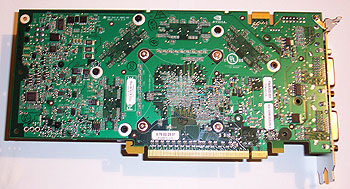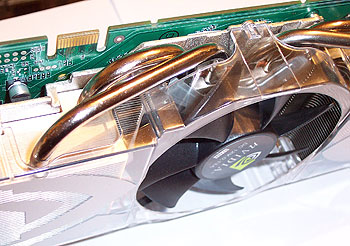Reference Board Examination
The reference board uses a revised Quadro FX 4500 PCB to power the slightly tweaked G70 GPU and the new DRAMs. The new PCB layout is also very similar to the GeForce 7800 GTX reference product, with the only real outward difference being the former's support for the new DRAMs. The Samsung K4J52324QC-BJ11 devices have 136 pins (solder ball pads in reality) with which to attach to the PCB for power and communicate with the GPU. Rated to 2.0V at 900MHz, the 1.1ns devices are run under their rated clock by 50MHz.The cooler is a single piece when removed, with a copper base plate for the GPU interface and aluminium for the rest of the heatsink assembly, including the memory device interface spots. Use of aluminium keeps the weight down to 630g. As you can see, the dual-slot cooler (a return to such things for a flagship NVIDIA desktop product) uses a 92mm fan to pull in air and move it out of the chassis via the backplate vent, but also into the chassis too over the right-side heatsink assembly, across the heatsink fins.
The heatpipes you can see connect the copper GPU plate to the rest of the heatsink and they definitely play their part, getting very hot to the touch under load during testing.
The rear of the board shows how the heatsink and fan assembly is retained to the PCB, NVIDIA declining the use of a retention plate as seen on the rear of the original GTX. There are no memory modules on the rear of the board this time, though, all eight sitting on the same side as the GPU.
Dual DVI ports (the one nearest the mainboard is dual-link DVI) are provided of course, and the board takes power from an external 6-pin source as well as over the bus. The SLI connector is visible front and back, confirming that lucky people with a pair can twin them for extra speed and image quality.
The heatpipes are seen more clearly from that angle and this.
The GPU, still marked as A2 revision silicon - with a production date of week 34, 2005, which is roughly the last week in August and over a month before Radeon X1800 XT was launched - but this time with the marking of GF-7800-U (along with the clear indication it's an engineering sample). Clearly a nod to the flagship 'Ultra' variants of old, NVIDIA still choose to use the designation for GPU respins. Of course you could also take the view that NVIDIA always planned an Ultra product and this silicon was for that named SKU at some point.
Compare it to the old die for reference (week 17, end of April, start of May). Die sizes are the same.
Cooling and noise
Dave Baumann, Editor-in-Chief of Beyond3D, remarked to me earlier today that the mounting holes for a Radeon X1800 XT's cooler match up with the GTX and GTX 512, and that an interesting comparison between the three coolers could maybe be done. Using camera tricks you can see he's right. Without the time to do so, I'll leave that for another day (unless enterprising editors beat me to it, if indeed the coolers can be used that way on PCBs they weren't designed for).I did manage to use the GTX single-slot cooler on the GTX 512 for a while (it works fine for cooling the 550MHz GTX 512), however. Obviously the 512's cooler would work on the original GTX, the only issue being the memory module cooling on the rear.
The GTX 512's cooler is quiet and efficient (plenty of heat under load is moved out of the chassis, although a similar amount is pushed back in because of its design) and makes a very tolerable noise at all speed settings. Without a scientific measurement, I'll still venture the opinion that it's no louder than the original GTX. The ATI Radeon X1800 XT's reference cooler is clearly much louder than either, making the NVIDIA hardware much easier to live with should cooler noise bother you.
Even at full chat, it didn't irritate, and because of the larger fan size it doesn't have to spin as fast as the blower in the GTX, further keeping the noise down to minimal levels. Really good stuff, despite taking up two slots. That's the only downside compared to a GTX; a bummer if it blocks off a slot you really want to use.
Power
NVIDIA claim that compared to the original GTX and its maximum power draw of 100W, the GTX 512 boards at 550MHz and reference voltage levels should need about 20W more, under load. It's tempting to believe them, although the numbers don't quite add up. Quickly measuring it with a load meter - plugged in between mains and test rig PSU - shows between 22W and 37W more power draw depending on the load condition, compared to a reference GTX under the same stress. Not quite 20W (20% remember), but suitably close.
HEXUS ran the GTX 512 with Athlon 64 FX-57 processor - CPU sometimes overclocked to 3.0GHz while testing the GTX 512, mainboard with 1GiB of DDR400 memory, CPU cooler, HDD, DVD-ROM and floppy drives connected - from a 420W Tagan TG420-U02 power supply, without any stability issues. Indeed, the input power was less than 320W at all times (even overclocked on the CPU), translating into a rough 220W of output power needed from the PSU, to run all of those parts under load. Such is the inflated power requirements of the modern PC component when NVIDIA claim 350W minimum, just to cover themselves from the odd PSU horror. Just feed it with something that provides up to 13A on the +12V rail used to connect it.
Need help choosing a new PSU for your new GTX 512, GTX or similar? We looked at a few earlier this year that will do just fine.













